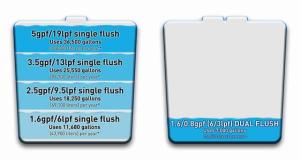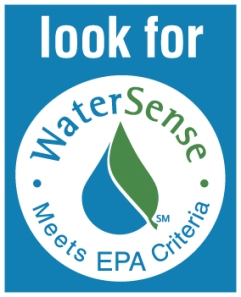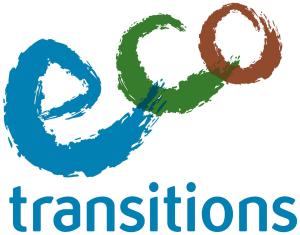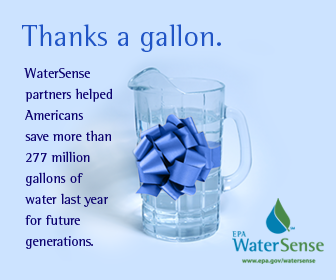Toilets account for almost 30% of residential indoor water use in the United States.
Toilets are also a major source of wasted water due to leaks and inefficiency. In a home that was built prior to 1993 it is most likely that the toilet uses 3.5 gallons or more for every single flush (in Dekalb County alone, approx. 165,000 homes were built prior to 1993 – there are approx. 1 Mio. Homes in the Greater Atlanta area that still have old, inefficient toilets in use). Experts say that the minimum needed to meet the basic human needs of drinking, cooking and hygiene is five gallons of clean water per person per day. It’s far from enough to ensure health and well-being-just enough to get by. Do we really need to flush down that much each time we go “Number One”?
In the beginning of modern toilets there was the seven-gallon flushing porcelain lavatory. Then there was the low-flush toilet. And by the time you’d flushed several times the bowl was “clear” and you had flushed more water than you did with the faithful lavatory.
Then there was the new and improved low-flush toilet, which was better but still not what always got the job done. And finally, the High-Efficiency toilet arrived; you now have your choice of flushing as little as .8 gallons with dual flush toilets. The best part is that they really work!
What Are High-Efficiency Toilets?
Under federal law, toilets must not exceed 1.6 gallons per flush (gpf). High-efficiency toilets (HETs) go beyond the standard and use less than 1.3 gpf. The WaterSense label will be used on HETs that are certified by independent laboratory testing to meet rigorous criteria for both performance and efficiency. Only HETs that complete the third-party certification process can earn the WaterSense label.
Do High Efficiency Toilets Work?
Everyone is concerned about the performance of low-flow toilets. Do they clear the bowl and leave it clean? Do they stop up frequently? Unlike the first 1.6 gallon / flush toilets, WaterSense HETs combine high efficiency with high performance. Advances in toilet design permit WaterSense HETs to save water without loss of flushing power. In fact, many perform better than standard toilets in consumer testing. Want proof? Watch this amazing video of Eddie Wilcut, the Water Conservation Manager for the City of San Antonio, flushing a Russet potato down a Caroma toilet with the full flush (1.6 gallon) AND half flush (0.8 gallon), which is meant for liquid waste.
How Much Water and Money Do HETs Save?
High efficiency toilets save you money by reducing your water and wastewater costs. Over the course of a lifetime, an average person flushes the toilet nearly 140,000 times. If you install a WaterSense HET, you can save 4,000 gallons per year and your children can each save about a third of a million gallons during their lifetime. If a family of four replaces one 3.5 gpf toilet made between 1980 and 1994 with a WaterSense toilet, they can save $2,000 over the lifetime of the toilet. If the toilet being replaced was made before 1980, it uses 5 gallons per flush so the savings will be much greater. If you’d like to calculate how much water you can save try the water savings calculator on www.ecotransitions.com.
With these savings, new high-efficiency toilets can pay for themselves in only a few years. Even better, many local utilities offer substantial rebates for replacing old toilets with HETs. Detailed information on the rebates available in Georgia can be found here Rebates in Georgia.
What are Dual Flush toilets?
 Dual flush toilets offer a patented dual flush technology consisting of a 0.8 Gal flush for liquid waste and a 1.6 Gal flush for solids. They can save up to 40% (approx. 4600 gallons) compared to today’s standard 1.6-gallon single flush toilets. On an average of 4/1 uses a day, Dual Flush toilets have the lowest water consumption of all – 0.96 Gallons per flush. Caroma, an Australian manufacturer that invented the Dual Flush technology manufactures award winning toilets that are both user friendly and, with a full 3.5″ trap way, virtually blockage-free! Wouldn’t that be nice to be able to finally kiss the plunger good bye? Beware of some products reducing the amount of water flushed to use with your existing toilet. Existing bowls are not designed to perform with reduced amounts of water, so the likelihood of clogging your toilet while you are trying to flush paper and solid waste increases drastically.
Dual flush toilets offer a patented dual flush technology consisting of a 0.8 Gal flush for liquid waste and a 1.6 Gal flush for solids. They can save up to 40% (approx. 4600 gallons) compared to today’s standard 1.6-gallon single flush toilets. On an average of 4/1 uses a day, Dual Flush toilets have the lowest water consumption of all – 0.96 Gallons per flush. Caroma, an Australian manufacturer that invented the Dual Flush technology manufactures award winning toilets that are both user friendly and, with a full 3.5″ trap way, virtually blockage-free! Wouldn’t that be nice to be able to finally kiss the plunger good bye? Beware of some products reducing the amount of water flushed to use with your existing toilet. Existing bowls are not designed to perform with reduced amounts of water, so the likelihood of clogging your toilet while you are trying to flush paper and solid waste increases drastically.
Select a WaterSense Labeled High-Efficiency Toilet!
Whether you are remodeling a bathroom, beginning construction of a new house, or just want to replace an old, leaky toilet, a WaterSense labeled HET is your best bet. Look for the WaterSense label on any toilet you buy. If every home in the United States replaced just one old toilet with a new HET, we would save almost one trillion (spelled with a T)
gallons of water per year, equal to more than two weeks of the water flowing over Niagara Falls!
Note that some manufacturers offer high-efficiency and ordinary models with very similar names, so be sure and look for the WaterSense label. A list of WaterSense labeled High-Efficiency Toilets can be found here List of WaterSense labeled HET’s published by the EPA.
Where can I find a HET?
To find WaterSense partners and resources in your area, please follow the link and click on your state below or choose from the list that follows. EPA – Where you live
For a watersavings calculator and more information on Dual Flush toilets please visit  www.ecotransitions.com.
www.ecotransitions.com.

Filed under: caroma, drought, Dual Flush toilets, ecotransitions, Plumbing, toilets, Urinals, water conservation | Tagged: 305 sydney, andrea paulinelli, best dual flush, caravelle, caroma, drought georgia, dual flush, Dual Flush toilets, ecotransitions, HET, high efficiency toilet, LinkedIn, low flow toilet, rebate georgia, toilet rebate, water conservation, watersense | 25 Comments »









